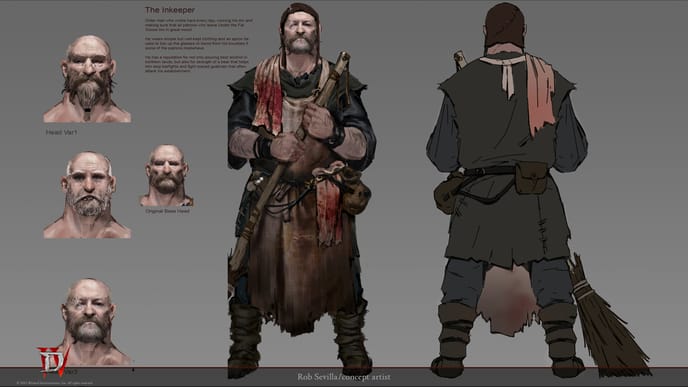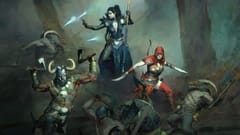
From Concept to Reality: The Making of Diablo IV
Posted by Liam Martines October 6th, 2023
In the dimly lit corridors of game development, where creativity converges with technology, the birth of a masterpiece is a journey marked by passion, challenges, and unwavering dedication. Diablo IV, the highly anticipated installment in Blizzard Entertainment's legendary franchise, stands as a testament to this process. In this exploration, we unravel the intricate tapestry of the making of Diablo IV, from the embryonic stages of concept to the realization of a dark and beautiful epic that promises to redefine the world of Sanctuary.
1. The Genesis of Ideas: Crafting the Concept
Every game begins as a spark of inspiration. The creative minds behind Diablo IV embarked on a journey to craft a concept that would resonate with the legacy of the series while pushing the boundaries of dark fantasy. Angela Martinez, Senior Art Director, shared insights into the genesis of ideas, stating, "We wanted to return to the series' darker roots while introducing new elements that would surprise players. The concept phase is about finding that delicate balance between nostalgia and innovation."
The process involves brainstorming sessions, concept art creation, and a relentless pursuit of a vision that captures the essence of the Diablo universe. Ideas are forged, discarded, and refined until the concept emerges as a guiding beacon for the development team.
2. Designing the Dark Aesthetic: Artistry and Atmosphere
Diablo IV's visual identity is a marriage of artistry and atmosphere. The dark aesthetic of the game is not just a palette of shadows but a carefully crafted symphony of visuals that immerse players in a world steeped in horror and beauty. Martinez discussed the challenges of designing the dark aesthetic, saying, "We want players to feel the weight of the atmosphere. It's about creating a visual language that communicates the horror and grandeur of Sanctuary."
From the haunting landscapes to the grotesque creatures that inhabit them, every visual element is meticulously designed to contribute to the narrative. The dark aesthetic is not a mere backdrop; it's a character in itself, shaping the player's emotional journey.
3. Technological Alchemy: From Ideas to Code
As the concept takes shape, the alchemy of technology comes into play. The transition from ideas to code involves a collaboration between artists, designers, and engineers. Tom Edwards, Lead Technical Artist, discussed the technological challenges, stating, "Bringing the dark aesthetic to life requires cutting-edge technology. We leverage the latest advancements to create a world that feels both hauntingly familiar and technologically impressive."
From dynamic weather systems to spatial audio, the technological backbone of Diablo IV is as crucial as its artistic elements. The marriage of art and technology transforms the concept into an interactive experience, where every line of code contributes to the immersion of the player.
4. Narrative Weaving: Crafting the Epic Story
Diablo IV is more than just a visual and technical spectacle; it's a narrative journey into the heart of darkness. The process of narrative weaving involves crafting a story that complements the visual and gameplay elements. Marcus Kane, Lead Encounter Designer, discussed the importance of storytelling, stating, "Every boss, every monster, is part of a larger narrative. It's about creating an epic story that unfolds through gameplay, drawing players deeper into the lore of Sanctuary."
The narrative is crafted through collaborative efforts, with writers, designers, and artists working in tandem to create a cohesive and immersive world. The story evolves as the game takes shape, with characters and events emerging as integral components of the player's journey.
5. Player-Centric Development: Iteration and Feedback
The making of Diablo IV is not a linear process; it's an iterative journey where player feedback plays a pivotal role. Mark Thompson, Lead Producer, emphasized the player-centric development approach, stating, "Diablo has a passionate community, and we value their insights. The iterative process involves constant feedback loops, playtesting, and adapting based on the player experience."
The game undergoes multiple iterations based on community feedback, ensuring that Diablo IV is not just a creation of developers but a collaborative effort between the development team and the players. The commitment to transparency and open communication with the community shapes the evolution of the game.
6. Challenges and Triumphs: The Rollercoaster of Development
The making of Diablo IV is not without its challenges. The development team faces technical hurdles, creative dilemmas, and the weight of fan expectations. Emily Chang, Technical Director, shared insights into the challenges, stating, "Every project has its moments of struggle. Diablo IV is a labor of love, and overcoming challenges is part of the journey. The triumphs are all the more rewarding because of the obstacles we've faced."
The triumphs come in the form of breakthroughs in technology, the successful implementation of challenging design elements, and the positive reception from the community. The rollercoaster of development is a testament to the dedication of the team in creating a game that goes beyond expectations.
Conclusion: A Dark and Beautiful Tapestry Unveiled
As Diablo IV edges closer to its release, the journey from concept to reality stands as a testament to the intricate tapestry woven by the developers. From the initial spark of inspiration to the collaborative efforts of artists, designers, and engineers, Diablo IV is a labor of passion, dedication, and creativity.
The dark and beautiful world of Sanctuary is not just a backdrop for demon-slaying; it's a canvas upon which the vision of the development team comes to life. As players prepare to descend into the abyss, the making of Diablo IV is unveiled—a narrative of ideas forged, challenges overcome, and a masterpiece that promises to redefine the dark fantasy genre.





